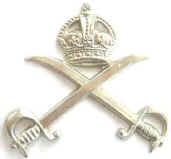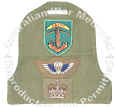 |
|
|||
|
|
||||
|
Badges for special qualifications including wounds, long service etc |
|||
Badges of the AIF for special training, wounds, overseas service and other special cases including long service and good conduct. |
 |
|
Salisbury, England,
1917-07. A studio portrait of 2919 Corporal Wallace Alfred ("Alf")
Jones, a physical training (PT) instructor, at the AIF encampment on Salisbury
plain. The badge of crossed swords
that he is wearing above his corporal's chevrons denotes his position as
a Physical Training
Instructor.
His belt buckle is a British pattern 14 buckle that he has probably donned for the photograph, to make his uniform look smarter. Corporal Jones was killed in action on 1918-03-17. (donor: P. Jones) |
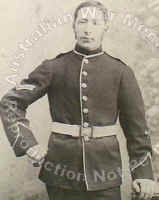 |
Castlemaine, Vic. c. 1887. Studio portrait of Corporal Robert Gartside (born 1862). Note the marksman badge on lower left sleeve. Gartside enlisted in the 4th Victorian Rifles in 1885 and was promoted to Corporal in 1887. He was wounded in the South African (Boer) War as a Lieutenant at Wolve Kuil on 14 February 1901 while serving with the 3rd Victorian Bushmen's Corps. He retired as a major in 1903. He re-enlisted in 1914, and served as Second in Command of 8th Battalion as an acting Lieutenant Colonel. He was killed in action at Gallipoli while leading a charge of the 7th Battalion near Tommies' Trench on 8 May 1915. He was posthumously awarded the Volunteer Decoration (VD). (Donor: G.W. Gartside). Photographer: A.Verey & Co, Castlemaine (Vic). | |
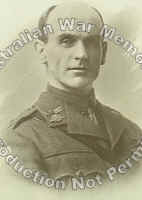 |
Lieutenant
Colonel E.H. Smith CB of the 12th Battalion, AIF. Note the additional
lapel badge.
This must have been a personal decision as the Dress Manual did not call for such a badge. (Donor Captain L.M. Newton) |
WW1 Corporal in a Signals Unit Worn by 3849 Corporal (Cpl) Frank McArthur. Cpl McArthur enlisted on 28 August 1915 and served with 13 Battalion. He was awarded a Military Medal at Zonnebeke in 1917, and returned to Australia on 13 April 1919. |
| Runner's
arm band. A runner is someone who
carries messages from the commander of a unit or sub unit to HQ or to
lower echelon people. Sometimes a runner was required to be running away
from the front lines. To ensure that there was no mistakes or
misunderstandings runners were made to wear a distinguishing arm band.
This was particularly necessary if British MPs were around as they would
shoot to kill any one they decided was 'malingering' or not taking a
proper part in an attack.
photo supplied by Grants Militaria |
||
| Army Order No.204 Headquarters, 1st A.N.Z.A.C., 9th August, 1916.DISTINCTIONS FOR OFFICERS AND SOLDIERS WHO HAVE BEEN WOUNDED The following distinction in dress will be worn on the service dress jacket by all officers and soldiers who have been wounded in any of the campaigns since 4th August 1914 :- |
|
Stripes of gold Russia braid No.1, two inches in length sewn perpendicularly
on the left forearm sleeve
of the jacket to mark each
occasion on which wounded. In the case of officers, the lower end of the first strip of gold braid will be immediately above the upper point of the flap on the cuff. Warrant officers, non-commissioned officers and men will wear the gold braid on the left forearm sleeve, the lower edge of the braid to be three inches from the bottom of the sleeve. Subsequent occasions on which wounded, will be placed on either side of the original one at half inch interval.
Gold braid and sews will be obtained free on indent from the Army Ordnance
Department; the sewing on will be carried out regimentally without expense
to the public. (see photo). It is probable that some men, particularly Officers, wore the metal gold wound stripe as seen below, on dress uniforms. |

|
| LONG
SERVICE BADGES A.I.F. ORDER
No.470, 24 January 1917
The question of the issue of a badge to members of the AIF who have completed a certain period of service has received consideration, and approval has been given for the issue of a badge for long service combined with good conduct, subject to the following conditions.
|
2233
Pte F Palmer 42 Bn (photo above) can be seen to be wearing
1
wound stripe, 1 long service stripe and 2 overseas service stripes
Australian Imperial Force Order No.1053, 4th January 1918 *(Slightly abridged) CHEVRONS FOR OVERSEAS SERVICE (see photo) His Majesty the King has been graciously pleased to approve of the award of chevrons to denote service overseas since the 4th August 1914.
The chevrons will be worsted embroidery, 1/4 inch in width, the arms 1/4 inch long. They will be worn inverted on the right forearm: in the case of officers, the apex of the lowest chevron will be 1 inch above the upper point of the flap on the cuff. In the case of warrant-officers, non-commissioned officers and men, the apex of the lowest chevron will be midway between the seams and four inches above the bottom edge of the sleeve. The red chevron will be worn below the blue one. They will not be worn on greatcoats. In the case of Australians, the first chevron was earned the date the individual left Australia. Additional chevrons were awarded for each successive aggregate period of 12 months service outside Australia. |

|
WW2 overseas service stripes, blue on light khaki twill. |

|

|
| This soldier is a Lance Corporal and wears the specialist badges of ??? | This soldier is wearing an unidentified badge on his left breast |
 |
Wound stripe. The "golden" wound stripe kit. The metal stripe went to the outside of the sleeve, the backing bar went inside and the spring pin held everything together.
|
 |
|
| WW2 mortar-man qualification badges. Issued in 3 classes, bronze, silver and gold. | School Cadets badge for Under Officers, i.e. a Platoon Commander. It dates from c. 1960-1973 |
 |
This Aussie is
a member of 13th Light Horse Regiment.
He is wearing the color patch of 2nd Division Mounted Troops (red and white diamond). He also wears the ANZAC "A" in brass (1917 issue not the earlier cloth type). The woven proficiency badge on his lower sleeve means he is either a saddler or harness maker. (see right) |
 |
 |
Unofficial Rats of Tobruk
Badge. Available ONLY to the men who served during the siege.
photo Bill Zroback, Ontario Canada |
 |
MELBOURNE,
VIC.
1943-09-24. A
Service Police Badge on the lapel of a Women's Auxiliary
Australian Air Force (WAAAF) jacket. |
 |

|
| PNGVR badges for command of English ^^^ | |
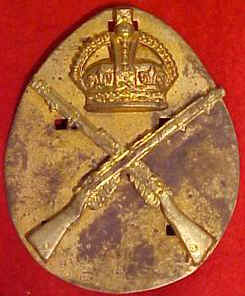
|
 |
| Metal Sniper sleeve badge. The large plate goes inside the sleeve leaving only the crown and crossed rifles outside. |
Marksman, 1930-42 |
 |
 |
|
|
|
Adjutant & Quartermasters Branch armband WW1 |
|
|
WWI Australian officers
tunic to the AFA with "Medically Unfit For Further Service "
badge to left shoulder.
Refer Page 58, Australian Army badges : cloth insignia of the army in Australia, 1860-1993 / J.K. Cossum.
|
|
|
WW2 Naval Telegraphists badge
|


